Sourdough Donuts with Cinnamon Sugar
These are true homemade Sourdough Donuts, made without any commercial yeast. A slow fermentation gives these donuts a spectacular flavor and texture. They’re like no donuts you’ve ever tasted.
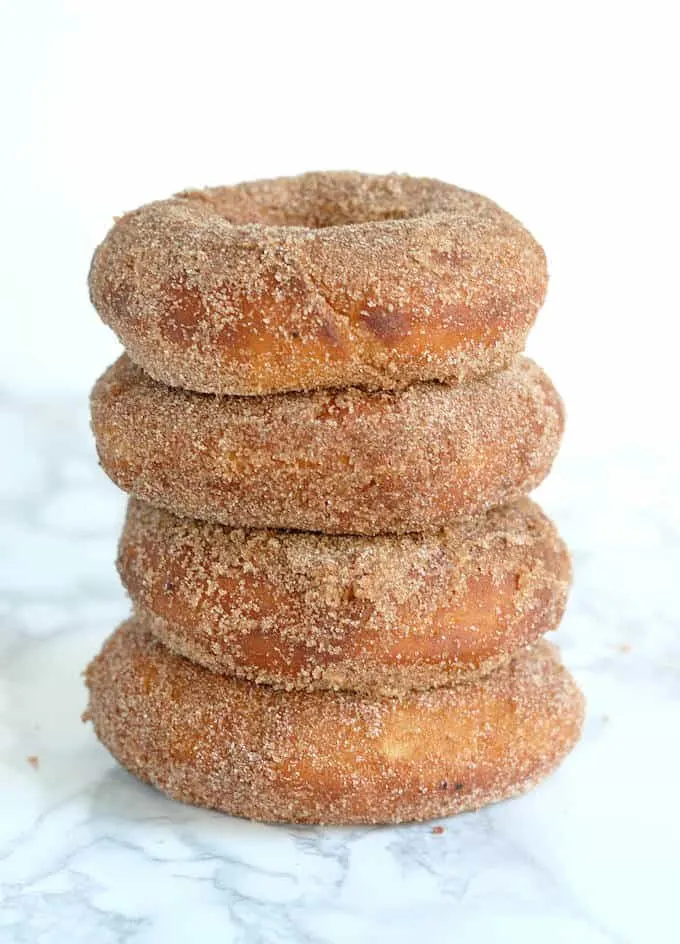
Table of contents
What makes Sourdough Donuts taste so good?
Making donuts with the natural yeast of a sourdough starter takes them into another stratosphere.
Seriously, these donuts are GOOD. The starter gives the donuts a special chewy texture airy crumb, and deep flavor.
If you don’t have one, check out my post to learn How to Make a Sourdough Starter. Then check out my system to Feed and Maintain Sourdough Starter.
The recipe is a 2 day process. Don’t worry though, the vast majority of time is hands-off.
I can’t wait to make these treats again. They’re totally worth the time and effort–and calories. Now, if you’ll excuse me, I need to jump on the elliptical…
Ingredients
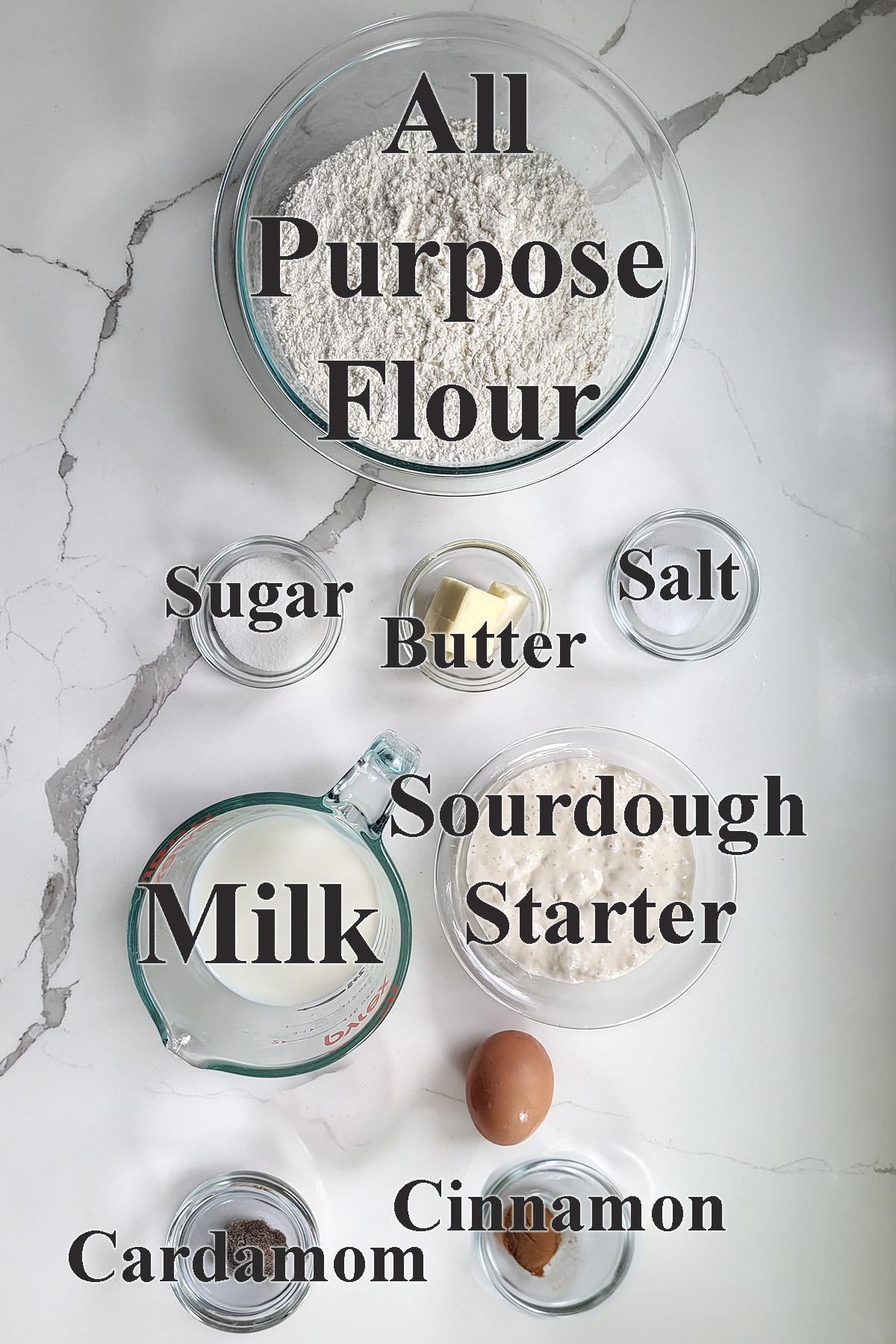
Ingredient Notes
- Sourdough Starter – Your starter should be well-fed and at peak activity when you make the dough. The recipe was developed using a 100% hydration starter.
- All Purpose Flour – Medium protein ap flour makes a dough that is strong enough to rise high in the fryer, but soft enough to make a tender donut.
- Sugar – Just a hint of sugar tenderizes and sweetens the dough.
- Milk – Scalding then cooling the milk alters the protein in the milk which can interfere with gluten development. Don’t skip the scalding step.
- Spices– A hint of cardamom is lovely along with the cinnamon. You can skip the cardamon if you prefer.
Process Photos
Here’s what the recipe process looks like at each stage. Refer to the recipe card below for measurements and exact instructions.
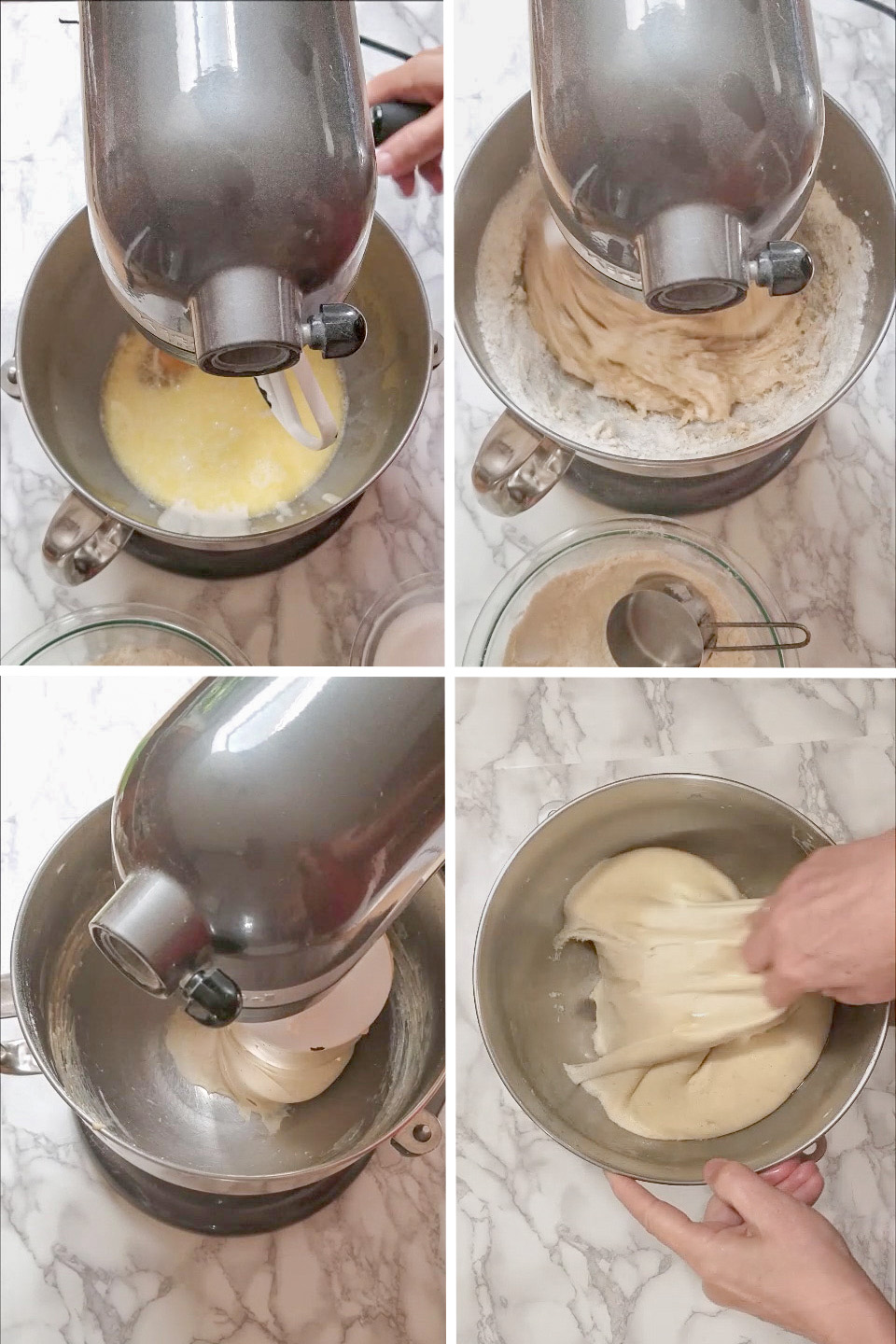
- Combine the milk, butter, egg and active sourdough starter in a mixing bowl or the bowl of a stand mixer. Mix using the paddle attachment.
- Add the sugar spices and some of the flour. Switch to the dough hook.
- Add the remaining flour and knead until the dough clings to the hook and clears the sides of the bowl.
- Set the dough aside at room temperature for 3-5 hours for fermentation. Every hour fold the dough. Refrigerate the dough overnight.
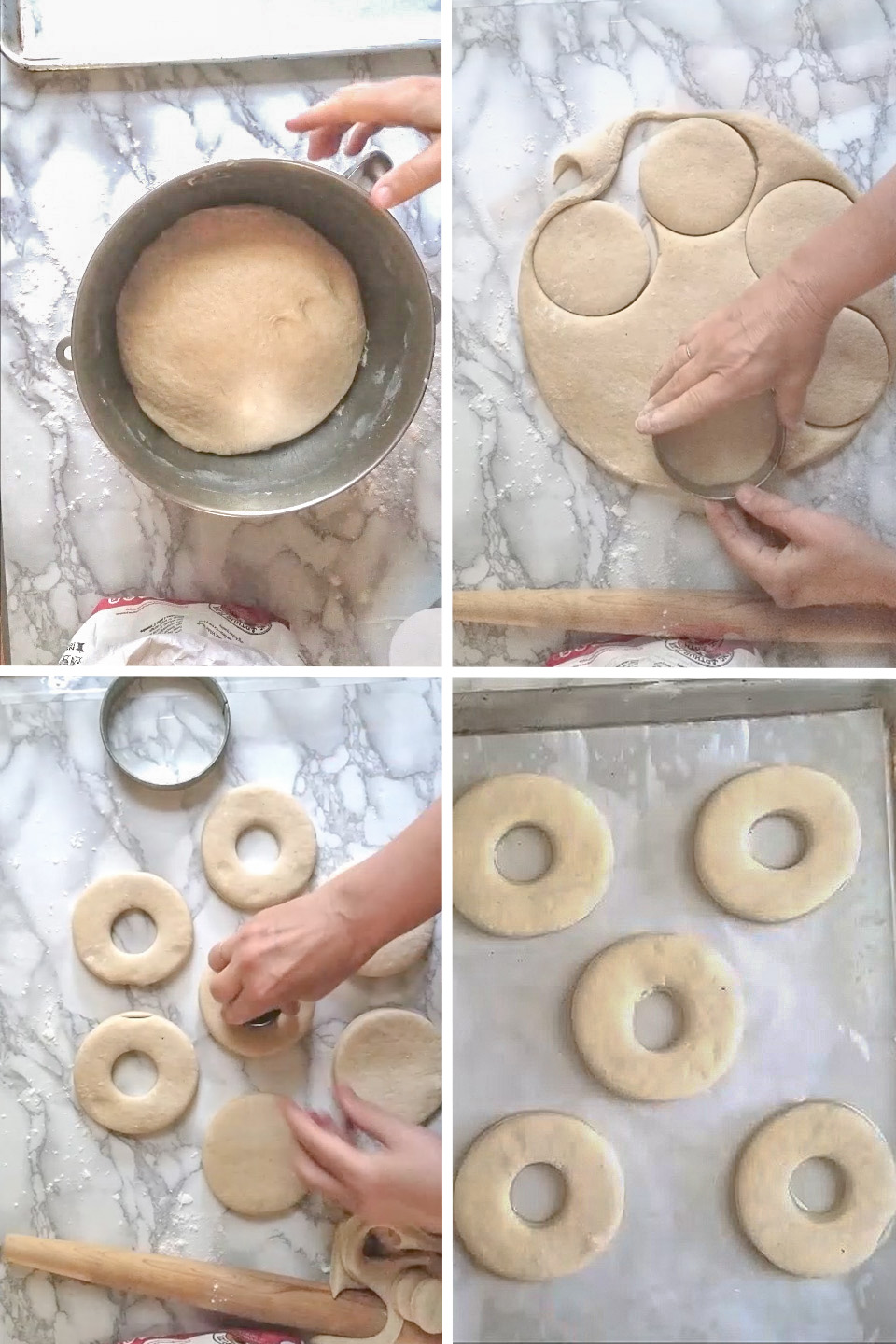
- In the morning, take the dough out of the fridge. Turn the cold dough out onto a lightly floured surface and roll to 1/2″ thick.
- Use a 3-4″ round biscuit cutter or cookie cutter to cut donuts. You can also use a donut cutter which has a center ring for cutting the holes. Reroll the scraps and continue cutting until all the dough is used.
- Use a smaller cutter to cut the donuts holes. You can re-roll the donut holes with the scraps or save them and fry them.
- Set the donuts into a baking tray lined with lightly oiled parchment paper. Cover and set aside until the donuts rise to almost double.
Did you know?
Sugar and cinnamon can slow down fermentation. Be patient with the dough and keep it in a warm spot to keep the dough active.
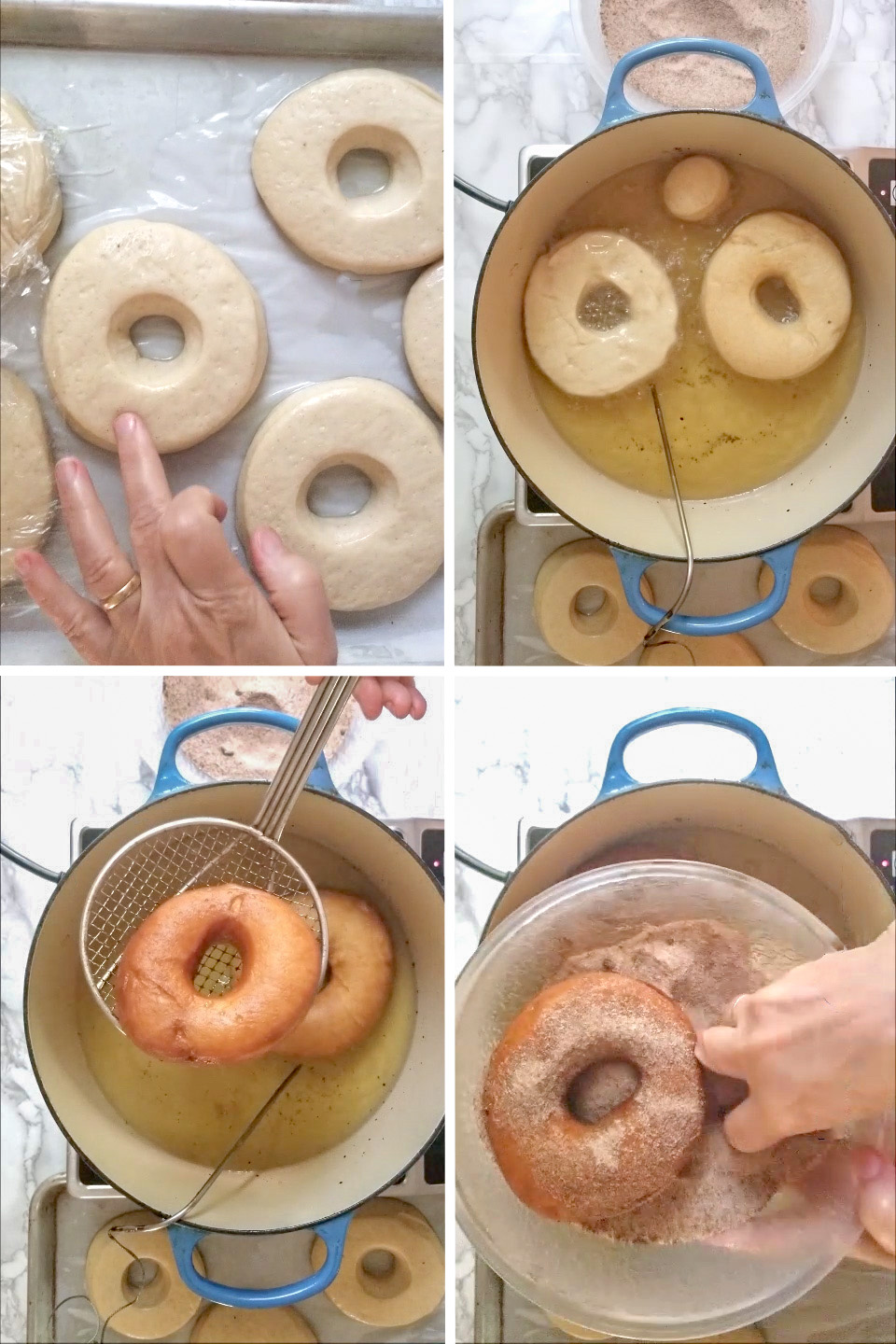
- While the dough is rising heat the oil until it registers 350F on a candy or probe thermometer. The dough is ready when the dimple slowly fills in when you press it. If it bounces right back it’s not ready.
- Fry the donuts a few at a time, flipping half way through to brown both sides.
- Lift the donut out of the oil and allow the excess oil to drip back into the pan.
- Immediately toss the hot donut in the spiced sugar.
Baking Schedule
- Feed your starter early in the morning of the day you will make the dough.
- Mix the dough in the afternoon. Allow it to ferment at room temperature until evening. The time will vary based on the temperature of the dough and the ambient temperature.
- Refrigerate the dough in the evening before going to bed.
- Take the dough out first thing in the morning and cut the donuts. Leave them at room temperature to rise for 1 1/2- 2 hours.
- Fry the donuts and serve while they’re still warm.
Variations
Glazed Doughnuts
Skip the cinnamon sugar and make a glaze. Combine 2 cups of powdered sugar with about 1/4 cup of milk. The glaze should be the texture of heavy cream. Allow the donuts to cool on a wire rack for about 5 minutes. While they’re still fairly warm dunk them in the glaze.
Baked Donuts
While the doughnuts are rising, preheat the oven to 400F. Bake until the donuts are light and golden brown, about 10-15 minutes. Toss them with spiced sugar or dunk in glaze while they’re still warm.
Filled Donuts
Do not cut a hole in the center of the dough rounds. Fry the donuts then allow them to cool. Fill a pastry bag fitted with a small, plain tip with jelly or custard. Poke the pastry tip into one end of the donut and pipe in the filling.
Storage
The donuts are best still warm from the fryer. They will keep at room temperature for 1 day. Leftovers can be frozen. To revive previously frozen donuts, warm them in a low oven.
I know you hate to throw away that sourdough discard. Check out these recipes that use sourdough discard.
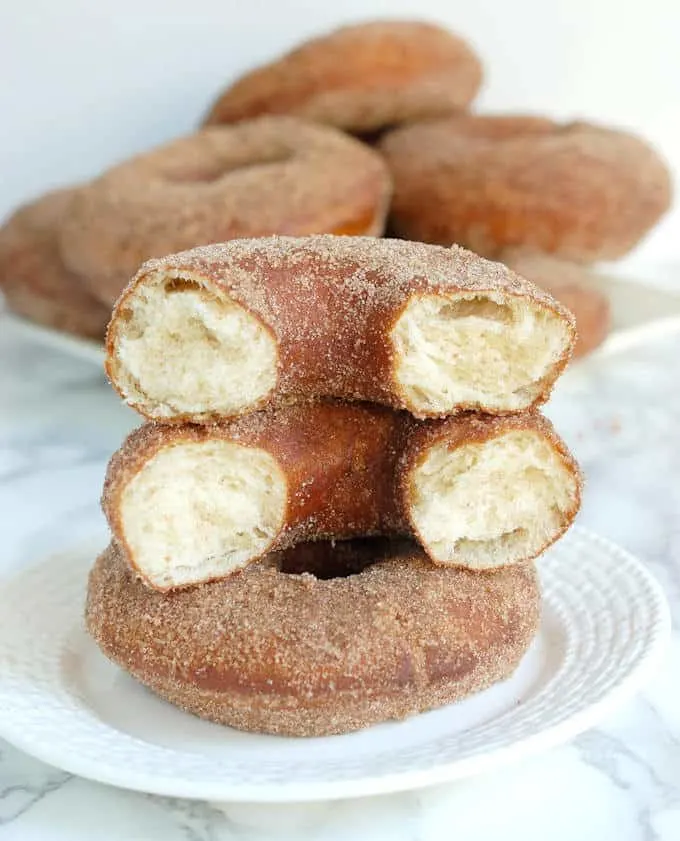
If you love this recipe as much as I do, I’d really appreciate a star rating and a quick comment. Ratings and comments help my recipes show in search results. Thanks!
Sourdough Donut Recipe
Video
Ingredients
- 8 oz whole milk (1 cup, warmed to about 110°F)
- 1 large egg (room temp)
- 2 oz unsalted butter (melted)
- 8 oz active sourdough starter (1 cup)
- 17 ½ oz unbleached all-purpose flour (3 ½ cups, see note)
- 4 oz granulated sugar (½ cup)
- 1 teaspoon cardamom
- 1 teaspoon cinnamon
- 1 teaspoon table salt
- Cinnamon Sugar for coating
Instructions
Make the dough (day 1)
- Combine 8 oz whole milk, 1 large egg and 2 oz unsalted butter with 8 oz active sourdough starter in a mixer bowl. With the mixer running, add 4 oz granulated sugar, 1 teaspoon cardamom, 1 teaspoon cinnamon, 1 teaspoon table salt and 2.5 cups of the flour. Mix until it forms a thick batter.
- Switch to the dough hook and add the remaining flour. The dough will start out quite sticky. Knead on medium low speed for 15 minutes (speed 2 on my stand mixer) until the dough clings to the hook and clears the sides of the bowl.
- Scrape the dough into a lightly floured surface and knead into a smooth ball. Place the dough into a lightly oiled bowl, turning once to coat the dough. Cover and set the dough aside at room temperature for fermentation.
- After 1 hour uncover the bowl, lift one edge of the dough over into the middle of the dough. Repeat with the other three sides of the dough then flip the dough over. Cover the bowl and set aside.
- Every hour for another 2-3 hours repeat the folding as described above. After 3-4 hours of fermentation the dough should be lively, elastic and airy. If the dough is still sluggish give it another hour or two at room temperature. Cover and refrigerate overnight.
Make the Donuts (day 2)
- Remove the dough from the refrigerator. While the dough is still cold, without kneading, roll to 1/2" thick on a lightly floured surface.
- Use a 4" round cutter to cut donuts. Use a 1.5" cutter to cut center hole. Line the donuts on a lightly-oiled, parchment or silpat lined baking sheet, leaving space between the donuts for the dough to rise (I used 2 baking sheets). Reroll the scraps of dough and continue cutting donuts until all the dough is used up. Brush the tops of the donuts lightly with oil.
- Cover the sheet pans with plastic wrap and set aside to rise. The donuts are ready when you poke the dough and the dent slowly fills in. If the dough bounces right back it’s not quite ready. This rise should take about 1 1/2 hours. The time will vary based on the temperature of the room.
- Meanwhile, heat 2 quarts of oil to °350 °F in a large heavy pot. Fry the donuts a couple at a time, about 2-3 minutes per side, until golden brown and puffy.
- As you take each donut out of the oil, immediately roll in the cinnamon sugar to coat the entire donut. Set on a cooling rack while you fry the rest of the donuts.
- Best eaten warm or within a couple of hours of frying.
Would you like to save this recipe?
As an Amazon Associate and member of other affiliate programs, I earn from qualifying purchases.




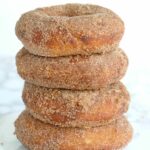






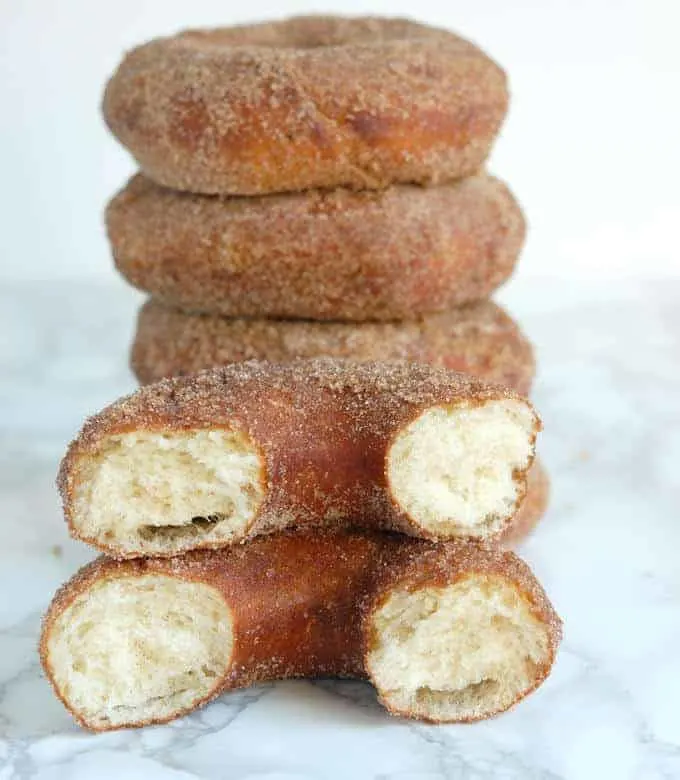
Following this recipe and made these donuts. I was a little skeptic watching the dough raise thinking they were going to be heavy donuts. I couldn’t of been more wrong. These donuts were a big hit. Probably the best donut I have ever eaten. I will make them again.
I have made these quite a few times and they never disappoint! Is it possible to freeze this dough for later use?
Hmmm, sometimes I don’t have great results when freezing sourdoughs. Personally, I would fry the donuts (don’t roll them in the sugar) then freeze. When you want to eat them re-warm them in the oven then roll in the cinnamon sugar. You can try freezing the cut, unfried donuts, but I can’t guarantee the outcome since sourdough can be so variable. If you try it and it works let us know how they turned out.
@Eileen Gray,
@Eileen Gray, I was wondering about freezing as well. It’s just way too many. I only want to make half a dozen at the most.
@Eileen Gray, I let them completely cool then freeze them on a cookie sheet. After a couple of hours, I put them in a freezer bag with any remaining cinnamon sugar and store in the freezer, pulling out individual doughnuts as desired. Not as good as freshly fried but still super tasty.
Thanks for the update.
@Eileen Gray, when you say you don’t have great results when freezing dough, what do you mean? The dough deflates? I would like to freeze the dough and fry them when I’m ready for them in a couple of weeks.
Well, sourdough leavened dough can be more fussy than a yeast raised dough. With commercial yeast, there’s so much yeast and it’s so active that even after freezing the dough there’s plenty of yeast activity to leaven the dough after freezing. I have frozen some sourdough successfully (cinnamon buns) but I’ve also frozen sourdough pizza dough and it was like a lead balloon after defrosting. If you want to freeze just make sure to use a very active starter to make the dough. I’m not saying it won’t work. Just that it’s a little more hit or miss than with commercial yeast.
Made these this morning. Awesome, came out perfectly – thanks for sharing the recipe. Next batch I might try baking them
Hi! After diagnosing (with your help) that my dense donuts were due to underproofing them once they’d been cut (and also that hubby had inadvertently refilled my plain flour bucket with cake flour so they may also have been suffering from low gluten), I decided to try again. This time they have behaved totally differently! I made the dough last night and gave it its proofing time over four hours then put them in the fridge (where they will stay until tomorrow morning, when I will cut and fry them). But when I woke up this morning, the dough had risen enormously in the fridge! Is this normal?
I’m concerned that if they have somehow overproofed in the fridge then they may have run out of oomph by the time it comes to the final proof and fry. Do they usually rise in the fridge overnight, or does this suggest maybe my fridge was too warm? And do you think this will impact their rise once fried? I’m trying to decide if I need to plan for the possibility of making an emergency batch of yeast donuts tomorrow morning if these ones don’t work….
Ahh, using cake flour will make donuts with weak gluten and cake flour absorbs much less water so the dough will also be way sticky. If the dough is rising is the fridge, that’s great. It means the yeast is active and happy. I do not think a day in the fridge will not kill off the happy yeasties.
Hi! I made the dough for these two days ago and fried them this morning. The flavour is great but they’re quite dense, not really at all fluffy like other (commercial yeast) donuts I’ve made or purchased. I make sourdough bread every week so I know my starter is active.
When I first dropped them into the deep fryer, they sank all the way to the bottom and took about 5sec to float to the surface, in contrast to previous (commercial yeast) donuts I’ve made where they floated almost immediately. Does this mean maybe they were underproofed, and this also contributed to the density issue when fried? After cutting them they proofed for over an hour and I followed your cues of a fingerprint very slowly filling back out, but they weren’t as puffy as my yeasted donuts usually are at that stage. I don’t want to give up on the idea of sourdough donuts but these weren’t the amazing success I was hoping for!
Did you watch the recipe video? You can see that the donuts do not sink when they go into the oil. The finished donuts should be fluffy and light. I would say either your dough was not sufficiently proofed or possibly over-proofed. If you dough is over-proofed you can loose volume when you pick it up to transfer to the oil. Did the donuts feel dense when you picked them up? Another problem could be weak gluten development. Without strong gluten the dough can’t maintain air as it rises in the oil. Did the dough feel springy when you roll it to cut the donuts?
@Eileen Gray, thanks so much for the quick response! I actually looked for the video when making as it was mentioned in the recipe post, but on my mobile browser could not see it – the only video visible on the page was for a brandy fruit cake. I’m on a desktop browser now and can see the video so I’m not sure what the issue was, but unfortunately it means I didn’t get to watch it.
I don’t believe the dough was over-proofed – they proofed for less time than you recommended and the room wasn’t excessively warm (it was early in the morning), and they if anything felt a little on the dense side when I picked them up (although puffier than when first cut). The dough was extremely springy when I rolled it out, so I don’t think gluten development was the issue. I need to produce donuts for a client this week and given your advice am now undecided as to whether I should try this again (and aim for better proofing) or revert to my usual yeasted recipe (which I was not entirely happy with, but at least came out fluffier than these)… Such a dilemna!
It does sound like they were underproofed. How did the previous days’ fermentation go? Did you get a nice rise during the long fermentation? With sourdough, I find the entire process affects the final outcome. As far as the video, after the donut video the player will continue to play a series of other videos. If you miss the donut video, you can reload the page and the player should start over again. Good luck.